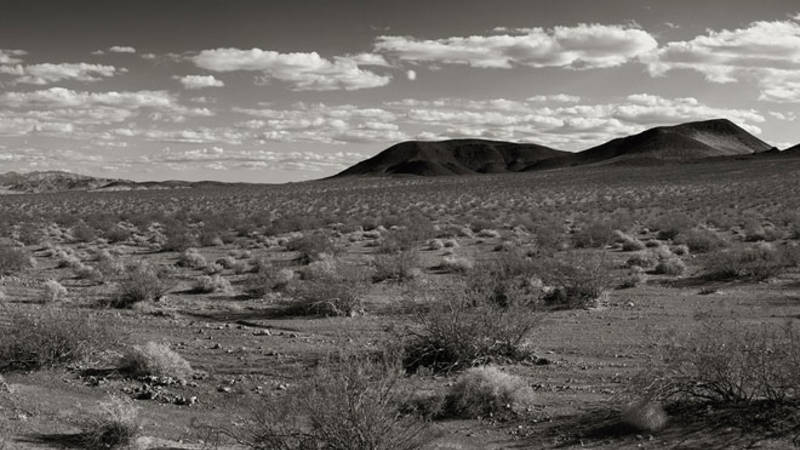Developers have proposed building the Soda Mountain Solar Project, an industrial-scale renewable energy facility, less than one mile from the boundary of Mojave National Preserve. It would be the closest renewable energy project to a national park site in the entire southwestern United States, in the middle of a critical pathway for desert bighorn sheep.
Mojave National Preserve and other California desert national parks are home to iconic Joshua tree forests and desert bighorn sheep. Unfortunately, they are still suffering from the effects of a “renewable energy gold rush” in which multiple industrial-scale solar proposals have impinged on our precious protected lands and waters.

Say No to Soda Mountain Solar
Why say no to Soda Mountain Solar? NPCA has 6 reasons highlighting what’s at stake near Mojave National Preserve.
See more ›Mojave National Preserve is home to the world’s largest Joshua tree forest, giant singing sand dunes, extinct volcanoes and lava flows, and beautiful mountain ranges with white fir and pinyon pine. If built, the facility would irreversibly harm a population of bighorn sheep that Americans have spent generations working to recover. It would also impact other important species like the desert tortoise, kit fox and burrowing owl.
In April 2016, the Obama administration approved the permit for this damaging, 2,000-acre facility. Fortunately, in August 2016, the San Bernardino County Board of Supervisors rejected the proposal, halting the project. However, NPCA remains vigilant, knowing the issue could resurface.
Our renewable energy future does not need to come at the cost of our national parks and incredible wildlife species. Although the Department of Interior has gone on record in favor of this irresponsible industrial solar project that would threaten this protected region, NPCA will continue to monitor the project and fight to protect Mojave National Preserve.
Background:
Solar Energy, National Parks, and Landscape Protection in the Desert Southwest
Solar energy is one of our country’s most promising industries for reducing America’s current reliance on coal-fired power plants that contribute to unhealthy air quality in communities across the country,…
See more ›The proposed project would occupy just under 2,000 acres directly adjacent to Mojave National Preserve. It would include a substation, access road, realignment of an existing route (Rasor Road), operations and maintenance buildings, and lay-down areas.
The Soda Mountain Solar Project threatens bighorn sheep migration corridors, desert tortoise habitat, natural areas, scenic viewsheds and the integrity of adjacent wilderness study areas. Moreover, the project’s groundwater pumping could harm water quality and quantity at Mohave Chub Spring in Mojave National Preserve, the home of the federally endangered tui chub, one of our most unique and rare desert fish.
Mojave National Preserve
There is both an economic and environmental imperative to protect Mojave National Preserve. Its 1.6 million acres contain spectacular examples of three out of four North American desert ecosystems: Sonoran, Mojave and Great Basin. It has elevations ranging from 800 to almost 8,000 feet above sea level; 600-foot-high singing sand dunes; the largest and densest Joshua tree forest in the entire world; relict white fir and chaparral vegetation that line high mountain peaks; and over 240 naturally occurring seeps and springs that provide sustenance for a wide variety of desert wildlife species. The preserve is a recreational haven for hikers, backpackers, bicyclists, stargazers, equestrians, botanists, history buffs and wildlife enthusiasts. As of 2010, Mojave National Preserve had over 600,000 recreational visits, and those visitors spent over $13 million in gateway communities and supported over 200 full- and part-time jobs.
Threats
There are significant threats from the project including the following:
- Desert tortoise. The proposed project is located in a key habitat linkage for the desert tortoise, identified by the U.S. Fish and Wildlife Service.
- Desert bighorn sheep. Biologists specializing in desert bighorn sheep conservation and management are working to delineate and re-establish key migration corridors for desert bighorn. These linkages connect areas supporting bighorn populations and, if protected and enhanced, will ensure that bighorn populations do not become genetically isolated. Isolated populations of bighorn sheep that become genetically isolated are less healthy and have a greater chance of becoming extirpated. In California, one of the more promising locations to re-establish gene flow across a major freeway (the I-15) is between the North and South Soda Mountains where this proposed energy project would be located. There are two ways that regular gene flow might be re-established. One is for bighorn sheep to go under existing highway bridges. Such bridges exist on Highway 15 between the North and South Soda Mountains. Although sheep are rarely crossing under such bridges, if at all, it may be possible to use the addition of drinking water to bait sheep to begin using some existing bridges. The other approach will be to build a bridge for bighorn sheep across the highway in a strategic location. Neither of these methods will work if the habitat on either side of the highway is made impassible for bighorn sheep by the construction or operation of this project.
- Groundwater. Groundwater pumping for the construction and operation of the proposed project could threaten the water resources at Mohave Chub Spring in the Mojave National Preserve. Mohave Chub Spring supports a population of the federally endangered Mohave tui chub, one of our rarest desert fish. We are very concerned that pumping of naturally limited groundwater to support the project may adversely impact water quantity and quality at Mohave Chub Spring and the federally endangered Mohave tui chub.
- Nationally significant conservation lands. The proposed project is directly adjacent to the Soda Mountains Wilderness Study Area and the Mojave National Preserve. The project is not compatible with maintaining scenic viewsheds and the natural character of these two areas.
Get Action Alerts
Want national parks in your inbox? Sign up for NPCA email updates to receive news, features, and opportunities to make a difference! You can unsubscribe at any time.